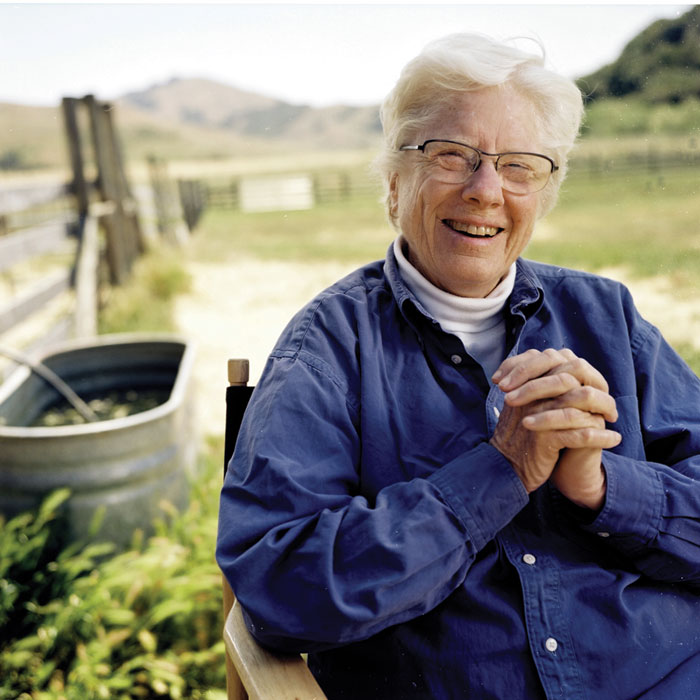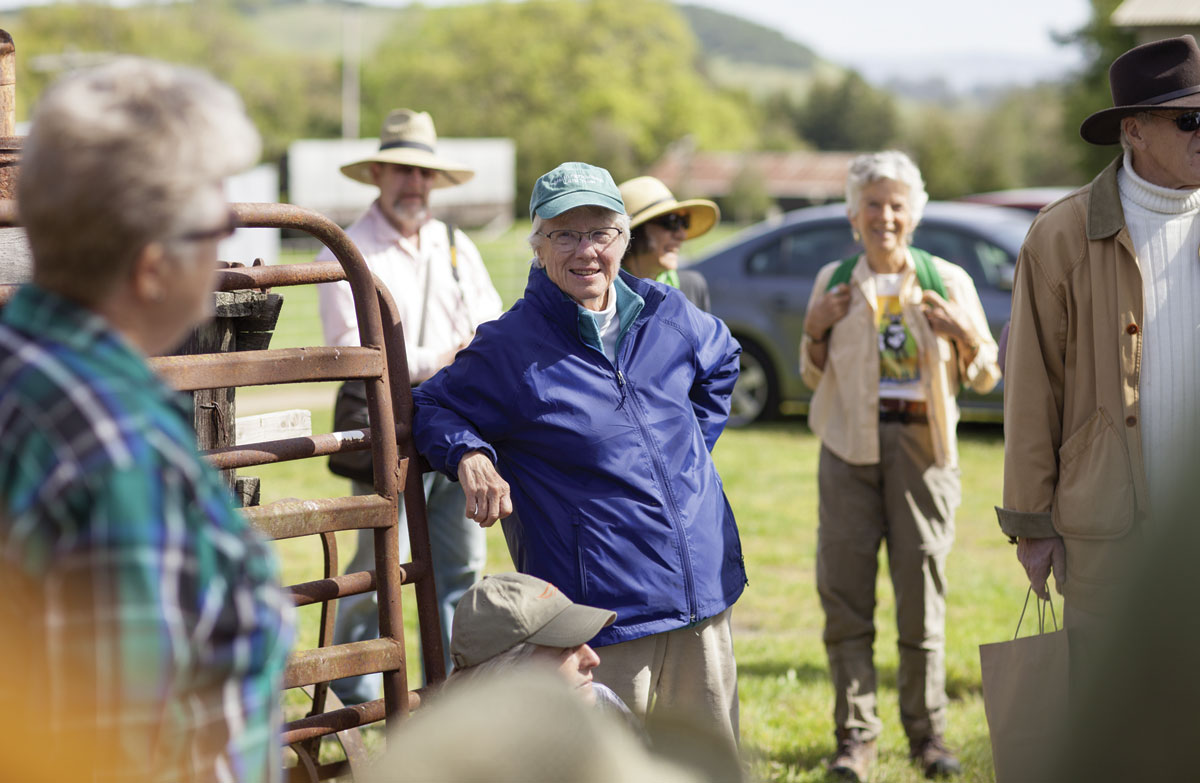Veteran environmental activist, writer, editor, publisher, educator, and coastal wetlands scientist Phyllis Faber has made countless contributions to the Bay Area environmental movement. With the late Ellen Straus, she cofounded the nation’s first agricultural land trust, Marin Agricultural Land Trust (MALT). She was a leader in the campaign for the California Coastal Commission in 1972 and subsequently served on the North Central Regional Commission, including as chair for two years.
Faber was born in New York City, graduated with a B.S. in zoology from Mount Holyoke College, and received her M.S. in microbiology at Yale. She first moved to the Bay Area for a few years in the early 1960s, then moved back to stay in 1971, settling in Marin with her husband and three children. She combined duties as a mother, a consulting coastal wetland biologist, a teacher of biology and natural history at the College of Marin, and an environmental advocate. She was also one of the founding instructors at the Environmental Forum of Marin.
She began her publishing career in 1982 when she wrote and published Common Wetland Plants of Coastal California. She has since worked on numerous books about California flora and ecosystems and served as editor of Fremontia, the journal of the California Native Plant Society, from 1984 to 1999. At age 87, she remains active in publishing as the coeditor of the Natural History series for University of California Press.
Bay Area environmental journalist David Kupfer recently sat down with Faber at her home in Mill Valley to reflect on her long career.
Bay Nature: What initially brought you to the Bay Area?
Phyllis Faber: My father was born in Oakland, as his father had immigrated here from Scotland around 1880. He eventually moved east, to New York, in 1927, which is where I was born. But he used to tell me wondrous tales about going up to Cooley Ranch in northern Sonoma every summer, so I learned about old-growth redwoods, oak forests, vineyards, and all the wildlife. My dad moved back to the Bay Area after he retired, as my sister and her family had moved out here earlier. When my husband, who worked for Xerox, was offered a transfer to the Bay Area in 1962, we jumped at the opportunity to come as well.
BN: What caused you to devote your life’s work to the environment?
PF: Having young children at home prevented me from taking a lab job doing what I had been trained to do, which was unraveling the structure of DNA. So I accepted a job teaching science at a private school in Connecticut. And the teacher I was replacing, Joy Lee, made it a point to inform me that we were losing our marshes and needed to protect them. She also made the connection between science and politics. She told me, “Do you know the world is going to fall apart because we’re losing our wetlands? You must pay attention to the wetlands.” It made a huge impression. I became fully engaged in the environmental movement through this issue of the loss of wetlands. So when we moved out to California, I was primed.

I started teaching with a group of biologists who taught out at Audubon Canyon Ranch near Bolinas Lagoon, and that was fun for me. I learned the flora of Marin County and what a wonderful place it was. And then, because of my concern about losing wetlands, I started working with Janet Adams on the campaign to create the Coastal Zone Conservation Act, Proposition 20. There were 10 miles of coastal beachfront that the developers of Sea Ranch on the northern Sonoma coast had blocked from public access. There were huge gravel mines being sited along the coast. And oil companies were gearing up for extensive offshore drilling. Exploitation of the coast was well under way. But there was no regional planning, and decisions were made by local governments that were largely interested in enhancing their tax base through development. That’s why the campaign to save the coast was essential. After the Coastal Act was passed by the voters, our local state senator, Peter Behr, appointed me to the regional Coastal Commission. That was life-changing for me. It was incredible to see how legislation can happen and to see what a change that legislation could make in the prospects for the coast. It changed California. And it was a citizen initiative; I’m really proud of the citizens of this state for having passed it.
BN: Why do you think environmental consciousness has flourished here? Has the relative material prosperity of the Bay Area influenced the conservation movement?
PF: The Bay Area has a rather exceptional population of people who love the environment. It might be expensive to live here but people are willing to pay the price. The educational opportunities and the beauty of the region attract activist types. The affluence means people have money and time to support nonprofit groups and the energy, education, and understanding to direct them. Also, the freedom that women have in California, the level of self-confidence, opportunity, and idealism that women have compared to other parts of the country, has really driven the movement.
BN: Can you tell us how you and Ellen Straus started MALT?
PF: Ellen and Bill Straus were West Marin dairy ranchers who opened up their ranch to me to bring out students from Drake and Redwood high schools as part of their school program. That’s how Ellen and I became great friends. At the time, in the late 1970s, land developers had been attracted to West Marin by the creation of the Point Reyes National Seashore and the tremendous population growth in the region. Ranchers, particularly those who were third- and fourth-generation, were reeling from the changes and many were selling their land; there were “For Sale” signs up and down Tomales Bay. Ellen and I talked about this situation and felt we had to do something. In 1978, we interviewed a number of local ranchers and heard from Boyd Stewart in Olema that land security was what enabled his family to stay in agriculture. He had sold his land to the Point Reyes National Seashore with a long-term lease-back. That’s how his family could count on a future in agriculture.

So we realized that a land trust might work by taking away the pressure for the rancher to sell his land. We went to the Trust for Public Land, which had experience with land trusts, and they endorsed the idea. Timing is everything. MALT developed at a particular moment when all the right people just happened to be working on related issues. And it turned out that an experimental land trust was an appealing alternative to the Coastal Commission staff’s suggestion to require a higher ratio of land to houses as a way of slowing development. This had been very controversial and the county supervisors were reluctant to impose what seemed unjust to much of the ranching community. So they agreed to let us try a land trust. Now, 35 years later, almost 50 percent of Marin’s ag land has been protected by easements, meaning that development rights have been extinguished in perpetuity. We chuckle today about the likelihood of a West Marin dairy woman and an East Marin biologist starting such a venture. It was a brand-new concept; no one had ever done anything like it. But now the idea has been replicated across the nation!
BN: Tell us about your work in the mid-1970s to help restore Muzzi Marsh in Corte Madera.
PF: The 1976 restoration of the Muzzi Marsh was the result of a mitigation measure required for the creation of the Larkspur ferry terminal. It involved breaching the bayfront dike, allowing tidal access to 120 acres that had been cut off in the late 1950s for commercial development. It was the first Bay marsh restored without any new plantings, just leaving it to nature. It was uncharted territory, and now we know how to do it even better. The model has since been replicated elsewhere; a lot of lessons learned at Muzzi have been applied in Sonoma, Napa, and the South Bay. It’s been exciting to see the end of the mass destruction of the Bay’s wetlands and the restoration of the Bay tidelands. Now, however, we’re worried about erosion of the marshes and how to hang on to and defend what’s been restored. The Bay is not receiving the sediment coming down from the rivers as it once did. It’s all been bottled up by dams slowing the flow from the Sierra. As a result, the marshes are not receiving the sediment they need to keep up with anticipated sea level rise.
BN: With your editing and publishing work over the past two decades, you’ve become a bridge between the scientific community and the public. Was that your intention?
PF: No, in a way I’ve been an opportunist. It was the choices and opportunities available to me at the time. I had the responsibility for my children. It was not the same then for men and women. But there was also the influence of my father early on and later Joy Lee, teaching me that to prevail, science has to fit together with policy in a political world.
BN: What are your favorite nature spots in the Bay Area?
PF: I am quite thrilled to be living here in Mill Valley next to the Bothin salt marsh, where I live with the daily tidal cycles and the myriad birds that visit the marsh. It is a treat to see the marsh plants when they have been enhanced by a recent rain. And I love walking out at Stinson Beach and up on Mount Tamalpais, on the Matt Davis and Nora trails. And I always love to stroll along the Bear Valley Trail at Point Reyes. Really, almost anywhere in Marin offers opportunities for adventure and delight.


